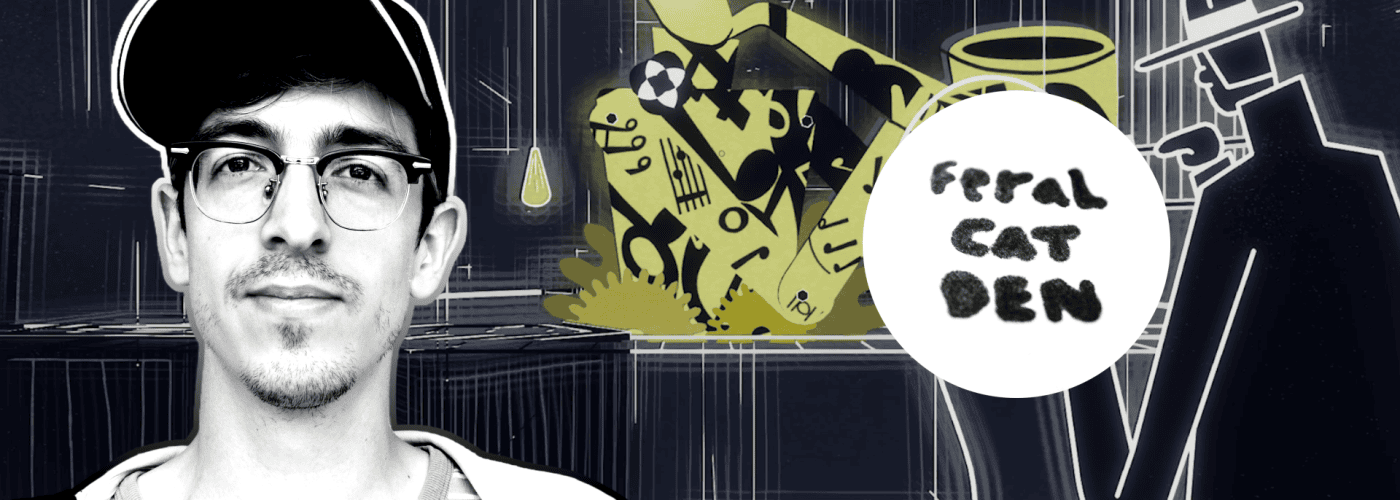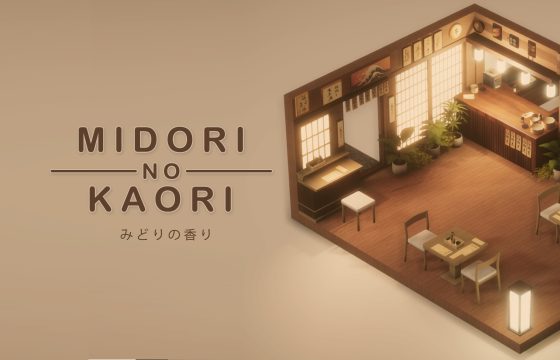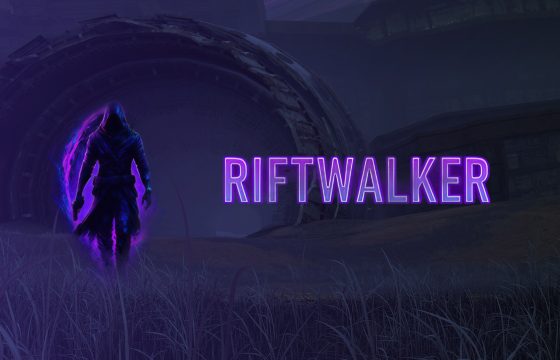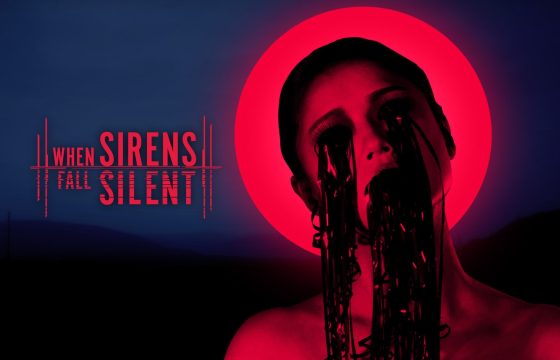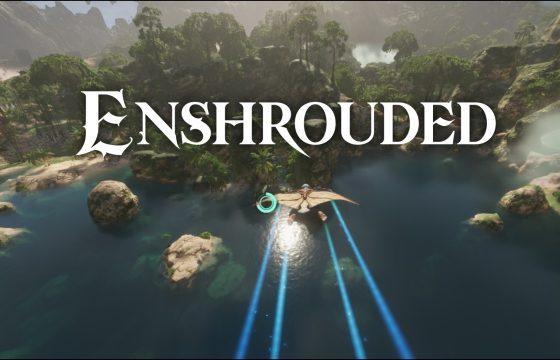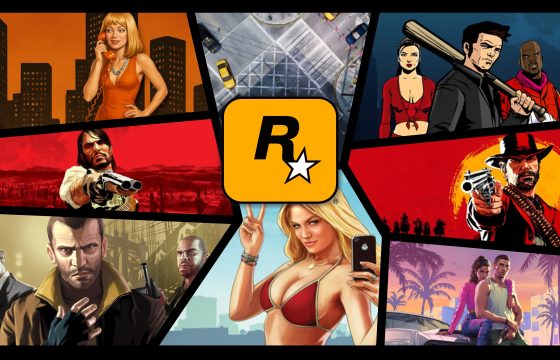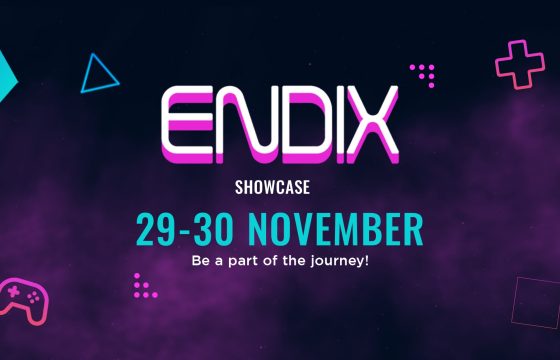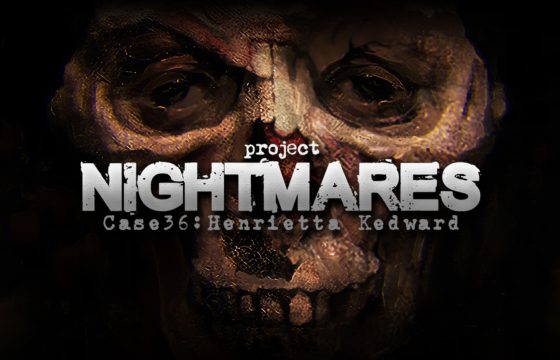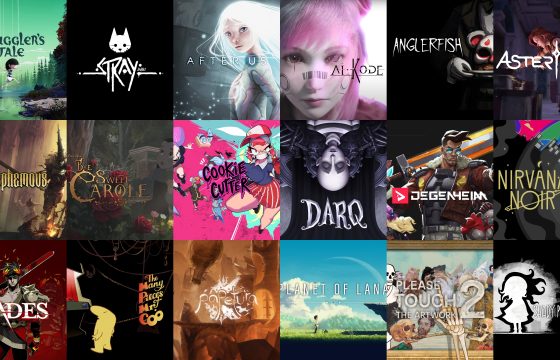We had the pleasure of speaking with Evan Anthony, Co-Founder and Creative Lead of Feral Cat Den, for an exclusive interview to delve into the creative and artistic vision shaping their original projects: Genesis Noir and Nirvana Noir.

We return with a fresh in-depth look at Nirvana Noir, the direct sequel to Genesis Noir—an irresistibly quirky, psychedelic noir adventure that stretches across time and space. Building on the foundation laid by its predecessor, the game deepens the journey of its ill-fated protagonist, No Man, delivering an electrifying story brimming with bold innovations, unexpected surprises, and twists that keep players on the edge of their seats.
Developed by the creative minds at Feral Cat Den and published by Fellow Traveller, the series made an indelible mark with Genesis Noir, swiftly establishing itself as one of the most inventive and dazzling titles in the indie game scene. With its captivating blend of a jazz-infused score, an unpredictably twisting narrative, and gameplay that artfully marries fresh concepts with original flair, it captured the hearts of a wide and devoted fanbase.
Nearly four years after the release of Genesis Noir, with the eagerly awaited Nirvana Noir now on the horizon, we seized the perfect opportunity to sit down for an exclusive interview with Evan Anthony, Co-Founder and Creative Lead of Feral Cat Den—one of the key architects behind the series. In this interview, we dive deep into the creative and artistic vision that brought the No Man saga to life, while also exploring the sequel’s direction, its evolution, the innovative elements it introduces, and the ambitious concept driving its development.
Introducing Evan Anthony and Feral Cat Den: The Visionary Team Behind Genesis Noir and Nirvana Noir
Before we dive into the interview, allow us to share a few words about today’s guest, Evan Anthony, and the project he co-founded in 2016 alongside Technical Lead Jeremy Abel: Feral Cat Den. This small yet exceptionally gifted team of artists harbors a dream of one day transforming a derelict barn into their creative sanctuary. While they await the fulfillment of this ambitious vision, they channel their boundless creative energy into their studio, crafting games, animations, web projects, and numerous other artistic endeavors.
Step by step, Feral Cat Den is steadily building a growing reputation in the video game industry, thanks to their distinctive approach that blends animation with interactivity, crafting immersive, innovative, and highly tactile experiences.

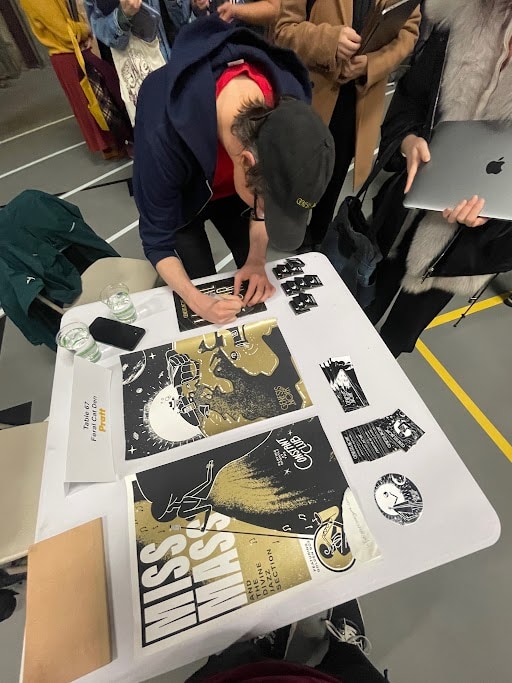
Born from a shared vision, the creative synergy of a talented duo who first crossed paths during their college years, and an unwavering ambition, Genesis Noir came to life in 2021. Their critically acclaimed debut resonated deeply with both players and critics, earning widespread praise that allowed the small studio to expand its horizons, embrace new opportunities, and evolve. Over time, they welcomed new talents into their ranks— Evan Stark (Producer), Marcin Zeglinski (Illustrator), Noah Sablan (Technical Artist), and Andri Arason (Illustrator and Animator)—ultimately forming a six-person creative collective.
This expansion ignited a renewed sense of ambition and confidence, allowing the universe of Genesis Noir to evolve into a fully realized saga. Currently in development, Nirvana Noir—the direct successor to their debut—has guided the team on an inspiring journey, with creative inspiration drawn from the vibrant streets of Brooklyn and Chicago to the stark, frozen landscapes of Iceland. This artistic odyssey has not only given birth to their second major project but also marks the culmination of our own journey—one that has traced the studio’s key milestones, bringing us to the present.
With this deeper understanding of Evan’s journey, the origins of Feral Cat Den, and its artistic evolution, we invite you to dive into the interview. Enjoy the read.
The Interview
Hello Evan, welcome aboard, and thank you for joining us today! If it’s alright with you, we’d love to kick things off with a direct question to break the ice and dive straight into your latest project, Nirvana Noir. How is the development progressing, and how do you feel about it? Are you satisfied with the direction Nirvana Noir is taking, or is there still work to be done to fully realize your creative vision?
Thank you for having me. I think, as with any game development process, things always end up being more complex than you initially anticipate. This is especially true for our current project, as we’re aiming for a more narrative-driven experience—one that lets players engage in multiple activities at once within a cohesive, ever-evolving world cosmic city. Here, different scenes unfold, and the city itself transforms as the story progresses.
Even handling the basics—like managing save states and ensuring smooth loading for the various narrative branches—is incredibly challenging. Every potential story event a player might encounter in this dynamic city presents a unique technical hurdle, something we didn’t face in our first game, which was built around a series of self-contained levels.
From a technical standpoint, we’re pushing ourselves further than ever before. Creatively, we’re also striving to craft a much more intricate and active noir narrative. This is a stark contrast to Genesis Noir, which had a minimalist plot and was more about poetic storytelling and character exploration, centering on the three main figures.
That said, we’re really enjoying the creative process. The challenges are tough, no doubt, but they’re also incredibly rewarding.
The Kickstarter campaign was a critical foundation for developing Genesis Noir, the predecessor to your current title in development. This step not only provided you with the necessary funds to meticulously craft the project but also helped you establish a closer connection with your community. You chose to follow the same path with the sequel, Nirvana Noir, which proved to be a successful move, even surpassing the achievements of Genesis Noir. So, why Kickstarter? What led you to start with this step again, and how did you feel before, during, and after the campaign? Did you anticipate such a strong response from the community?
We thoroughly enjoyed running our first Kickstarter campaign for a variety of reasons. From a business and financial standpoint, it provided invaluable insight into audience reception, helping us assess potential markets and refine the scope of our project. This direct feedback allowed us to pinpoint key areas that resonated with players while also identifying aspects that might need further clarification.
On a creative level, both our initial Kickstarter and this latest campaign have been incredibly rewarding. The process of presenting our vision to backers forces us to distill our ideas with clarity, and the experience of marketing the project plays a crucial role in shaping and refining its direction. Additionally, the responsibility of engaging with our community compels us to document our progress thoughtfully, which ultimately strengthens the creative process as a whole.
For Nirvana Noir, we’re especially excited to be working with Lost in Cult, an incredible publishing house that will help us produce an art book. Many of the assets and materials developed for our Kickstarter campaign will be featured in this book, adding a deeper layer to the project.
Another major reason we chose to launch a Kickstarter was to invite players to leave their mark on the game. In Genesis Noir, we introduced reward tiers that allowed backers to include personal messages within the experience. Initially, we hadn’t fully considered the impact of this feature, but once the campaign was underway, we were overwhelmed by the depth and thoughtfulness of the messages we received. Players engaged with the game’s themes in ways we hadn’t anticipated, creating something truly special. Some even told us they had read every single backer message, and certain game reviewers highlighted this aspect as a particularly meaningful part of the experience.
With Nirvana Noir, this feature takes on an even greater significance. The game explores themes of transcendence, and by allowing players to contribute their own messages, we’re reinforcing and expanding upon those ideas. Whether heartfelt, whimsical, or personal notes to loved ones, these contributions organically weave into the game world, enriching the narrative in a way that wouldn’t be possible otherwise. They don’t simply complement the story—they become an essential part of it.

Before we dive into your work on Genesis Noir and Nirvana Noir, we’d like to take a moment to explore the origins of your team. Feral Cat Den was founded on June 16, 2016, in Bushwick, Brooklyn, when longtime college friends Evan Anthony and Jeremy Abel—two creative minds fueled by shared dreams and ambitions—joined forces. Could you share the story of how and why Feral Cat Den came to be, and the guiding principles that drive your unique artistic vision in the gaming world?
I co-founded the studio with my classmate Jeremy, as you mentioned. We both studied New Media Design in college—a dynamic and multifaceted program that covered graphic design, motion graphics, animation, web design, and installation art, among other disciplines. It was an incredibly engaging field of study that allowed us to experiment across various creative mediums.
After graduating, we both moved to New York City and began working in advertising and product design. This period presented us with fantastic opportunities—whether it was developing an installation for the US Open, designing products at Google, or creating interactive websites to promote films and TV series. Our work spanned a wide range of subjects and aesthetics, offering us the chance to explore different creative possibilities.
Despite the diversity of projects, none allowed us to tell a long-form story. Most assignments lasted only a few months—an installation would be displayed at an event and then dismantled, or a promotional website would remain online for a brief period before disappearing. We found ourselves longing to create something with lasting impact, something that would endure beyond a fleeting campaign.
Since graduating, we had been collaborating on small creative projects, and over time, the idea of making a video game began to take shape. It took several years of exploration—creating concept art, testing prototypes, and refining ideas—while still balancing freelance work in advertising and product design. Eventually, the overwhelmingly positive feedback we received convinced us that people were genuinely excited about the project. That encouragement gave us the confidence to commit to it full-time.
We secured a studio space, officially launched our business, and started working with many of our talented freelance friends. For our first game, Genesis Noir, Jeremy and I worked full-time while several friends contributed part-time. With Nirvana Noir, we’ve been fortunate to bring some of those same collaborators on board as full-time team members. Marcin and Evan, who assisted us on Genesis Noir, are now fully dedicated to this new project. Our team has grown, and with it, our ambitions—we’re eager to create something even more expansive and engaging for our audience.


Your team’s name, logo, and overall brand identity—driven by the dream of eventually finding solace in a derelict barn—certainly evoke a sense of curiosity and charm. So, why did you choose this particular brand identity? Is there a special connection to the spirit of a cat, an interesting backstory, or was it a serendipitous choice? And do you envision a future where you might leave your Brooklyn studio to develop games in a real derelict barn amidst nature?
The studio’s name originated from a casual remark I made during our time in advertising. I often joked with my friends about taking a year or two off, buying a place, and moving in together to create unconventional art or perhaps start a business. I envisioned a cheap space, perhaps even one inhabited by feral cats. My friend Andy, in turn, began calling it the “Feral Cat Den,” and, surprisingly, the name stuck.
Initially, I wasn’t fond of it. I thought it felt too arbitrary, and I believed we should come up with something more carefully considered. But over time, I’ve come to appreciate it. There’s something special about how the name organically came to us, without being the result of a heavily thought-out brainstorming process.
When it comes to the visual identity and mission of the studio, I’ll admit I haven’t placed too much emphasis on a polished brand. My vision is for the studio to feel like an artist’s workshop, more focused on the work itself than on branding. Our creative goal is to merge our varied backgrounds and create a gaming experience that’s distinct. We aim to explore tactile interactions, generative art, and motion-graphic-inspired transitions, all serving to tell a story that stands apart in the gaming landscape.
Looking forward, I would love to expand our creative toolkit to include more traditional gameplay mechanics. My hope is to craft games that are more focused on core mechanics, but right now, with our first game, we’re still in the process of learning the fundamentals—how to create a game and tell a simple story. Each project is an opportunity for growth. With Nirvana Noir, we’re diving deeper, telling a more intricate story and building a more finely-tuned game world.
If we get the chance to develop another game, it would be exciting to further explore the poetic interactions we’ve begun and perhaps blend them with more traditional gameplay, creating a balanced experience.

A hallmark of your creative journey has been your exceptional versatility, allowing you to excel in diverse artistic fields, from animation and web projects to VJing. Given this broad spectrum, why did you choose to focus specifically on video games? Was it a passion-driven decision, knowing the complexities involved, or a personal challenge to explore your art in a completely new medium?
Our entire team shares a profound passion for video games, and we find the industry to be incredibly exciting. It provides us with the unique opportunity to merge various artistic mediums—animation, writing, music, and interactivity—into a cohesive, immersive experience. Video games allow us to create expansive, surreal worlds that would be nearly impossible to bring to life in the real world. From a creative standpoint, this medium offers us the freedom to explore endless possibilities, which is both inspiring and stimulating.
From a business standpoint, the indie game industry feels like a thriving and healthy space. It’s an environment where artists can directly connect with their audiences and receive the support necessary to bring their creative visions to life. While other art forms, such as short films or comics, also offer avenues for creative expression, we’ve found that securing funding for such projects can often prove more difficult—whether through grants or by gaining acceptance into film festivals.
In contrast, the indie game industry provides a vibrant and promising landscape both creatively and commercially. It offers a unique opportunity to not only pursue our artistic aspirations but also build a sustainable business model that allows us to bring those ideas to life.
Being an artist involves perceiving every subtle nuance of art—its colors, textures, and even sounds. It requires creativity, emotional insight, expression, sensitivity, and intuition. As the creators of a project born from a deep artistic drive, could you share your personal perspective on art? What do you believe is the true essence of creating art and being an artist?
I truly appreciate that question because it’s something I’ve been reflecting on deeply, especially after completing our first game, Genesis Noir. That experience was truly life-changing. Developing that game took us seven years, and it was an incredibly challenging journey—creatively, emotionally, and financially. It really transformed the way I view art-making and, more broadly, life itself.
At this stage, I’m convinced that art-making is not merely a personal pursuit; rather, it’s the art that shapes the artist more than the other way around. This is a perspective I continue to refine. I liken it to the act of drawing: when I put pen to paper, I rarely have a clear vision of what I’m about to create. I make a mark, and that mark, in turn, directs me, suggesting where to go next or what adjustments to make. Gradually, the drawing takes form, seemingly out of nowhere, driven by a series of small decisions and the intuitive movements of my hand.
The experience of working on longer projects has only deepened this understanding. I’ve come to realize that it’s not necessarily my deliberate intent that creates the artwork, but rather a succession of small, almost serendipitous decisions, unanticipated moments of synchronicity, and occasional misunderstandings within the collaborative process. These elements are what truly give shape to the art. And through that process, the artist, too, is fundamentally transformed.
I’ve come to see art-making as an incredibly meaningful, therapeutic, and spiritual journey—a process of self-improvement. Even though it’s often challenging and humbling, with very high standards for my work that I never quite meet, I’m always somewhat disappointed by the outcome, it’s still deeply gratifying. The journey itself is what makes it worthwhile. Does that make sense? I feel like I’ve rambled a bit, but it’s something I think about a lot.


In 2021, you released Genesis Noir, your debut game—a visually striking adventure that masterfully blends art, music, and gameplay, earning acclaim from both players and critics. As artists venturing into game development for the very first time, how challenging was the process of creating Genesis Noir, particularly regarding gameplay, game and level design, and world-building? Did you find yourselves comfortable in this new role, or was it difficult to adapt to this unfamiliar medium?
I find game design to be an incredibly captivating field. As a designer, your goal is twofold: you want to ensure clarity, so the player fully understands the options and affordances available to them, but you also aim to preserve the thrill of discovery, ensuring things aren’t so obvious that they lose their sense of wonder. Striking the perfect balance between clarity and discovery, challenge and usability, is a delicate and ongoing process that demands significant iteration and playtesting. For a small team like ours, it’s a constant challenge to allocate both the time and the budget required to execute these elements with the depth they deserve.
I believe that any form of art or design is a humbling experience. Even something as seemingly simple as creating a logo or a poster can be remarkably difficult when trying to convey a clear idea. You could place two words on a page, and people will interpret them in vastly different ways. The same holds true for logo design—one person may feel it evokes a particular emotion, while another might have a completely different interpretation. In game design, you’re balancing a multitude of elements—the visuals, the sound, the story, and the interactivity—all working in concert.
It’s a deeply enjoyable and rewarding challenge, particularly for someone like me, who has been profoundly influenced by games. It leaves me with a deep sense of appreciation for any piece of artwork that manages to successfully integrate all of these elements. Honestly, I consider it nothing short of miraculous every time it happens.
Since the release of Genesis Noir, your team has expanded from 2 to 6 members, with the additions of Evan Stark as producer, Marcin Zeglinski as illustrator, Noah Sablan as technical artist, and Andri Arason as illustrator and animator. This growth has undoubtedly raised expectations for the sequel, Nirvana Noir. How has this expansion influenced your ambitions and the development process, and what impact do you anticipate these changes will have on the sequel?
On Genesis Noir, our team was much larger than just two people. We often worked closely with our friends, bringing them in as freelancers. There are clear pros and cons to working with full-time team members versus freelancers. When freelancers joined the project, we found it beneficial for them to take breaks and work on other commercial projects to replenish their finances, which allowed them to return with a fresh perspective. However, the trade-off was the time spent getting them up to speed, and they didn’t have the same deep understanding or level of investment in the project as full-time members.
As we expand the team, our goal is to have everyone more deeply involved and committed to the process. With a larger team, we are able to undertake much more complex storytelling because more people are immersed in the project, understanding its every nuance. A narrative like ours—one that is layered with intricate characters, organizations, and conspiracy—is simply too much for just two people to handle effectively. It really demands a larger team to scrutinize each detail: Does this make sense? What could happen here? How do we address this challenge?
In the end, I don’t think this kind of story could have been fully realized with a smaller team.
What truly surprised us about the No Man saga, even before its stunning art and concept, was the deeply inspired, original, and unconventional narrative that drives the protagonist through this symbolic noir world. Could you tell us more about how this story came to be? How did the initial narrative script that brought No Man’s story to life come about? Were there any specific inspirations—whether artistic, literary, or otherwise—or was it entirely driven by your imagination and creativity?
The story of Genesis Noir was deeply influenced by Italo Calvino’s Cosmicomics, an extraordinary collection of short stories where each narrative begins with a scientific concept. However, Calvino doesn’t use these ideas to educate the reader on the technicalities of the concepts themselves; rather, he uses them as a springboard for his imagination, crafting profoundly human stories set against a cosmic backdrop. One story that particularly resonates with me is “The Distance of the Moon.“ Calvino begins by explaining how the Moon was formed after Earth collided with another celestial body, creating a debris field that ultimately coalesced into the Moon we see today, settling into its orbit over an immense span of time.
Calvino then explores the lives of people living on this primordial Earth, where the Moon is gradually moving away and constantly changing in size and shape. He takes this fascinating scientific concept and spins it into a whimsical, yet poignant tale. For example, he imagines the Moon’s proximity creating tidal forces that pull the oceans into mountainous peaks, and people rowing out in boats to climb ladders that connect the ocean mountains to the Moon’s surface. Calvino’s brilliance lies in his ability to take these scientific notions and transform them into rich, imaginative stories that engage both the analytical and creative sides of my mind.
That book left a lasting impression on me, and I found myself continuously reflecting on its themes. One day, while walking across a bridge in New York City and taking in the skyline, I found myself pondering this piece of art I admired and imagining other stories that could emerge from different scientific concepts. It was then that the idea struck me: the Big Bang could be a perfect foundation for a film noir story. The creation of the universe, viewed through the lens of a noir mystery and drama, felt like an intriguing concept. It was a perfect opportunity to blend genre conventions with our own experiences living in New York City, all while drawing inspiration from Calvino’s unique approach.
This concept felt like the ideal narrative to pursue. Jeremy, who shares my enthusiasm for Cosmicomics, also found inspiration in these ideas. We were able to meld our diverse interests—such as Jeremy’s passion for jazz drumming, our shared love for film noir, and even philosophical elements like the Zen and Wabi-sabi of feudal Japan—into a unified, cohesive story. Ultimately, all these influences came together to shape the narrative of Genesis Noir.

When you released Genesis Noir, you also collaborated with Jay Quercia on Moiré Noir, an intriguing interactive digital comic that served as a prelude to the game’s events. Are you considering creating another comic for the upcoming launch of Nirvana Noir, perhaps to bridge the gap between the end of Genesis Noir and the beginning of Nirvana Noir? And without giving too much away, can you tell us how much time elapses between the two games? Are we looking at a significant time jump or more closely linked timelines?
Yes, we’re definitely working on a comic that acts as a prequel, setting the stage for the narrative where the game begins. Nirvana Noir is split into two distinct halves: one follows a black-and-white timeline, heavily inspired by classic noir, and the comic you’re referring to, Moré Noir, takes place before this timeline. The second timeline in Nirvana Noir unfolds in a vibrant, psychedelic neon world, and we’re developing a comic that sets up that part of the story.
So essentially, we’ll have two comics that bridge the gap and provide clarity on the events between the two games. As for the time between them, it’s hard to pinpoint an exact duration, especially within the context of this cosmic universe. But if I had to estimate, I’d say it’s about a month or two, give or take.
Nirvana Noir will be your second video game, the direct sequel to Genesis Noir, your first IP that marked your official debut as an independent game studio. Why did you decide to continue No Man’s saga right away instead of venturing into something entirely new? Was this choice driven purely by your passion and connection to the story, or did you feel a particular urgency, believing that the saga deserved an immediate sequel?
After completing Genesis Noir, we brainstormed several game concepts to pursue next. We presented these ideas to a variety of people, and we’re still genuinely excited about them. We continue to develop them, gathering references and noting down ideas as we go. However, the story of Nirvana Noir felt like a natural continuation for us. In the early stages of the project, we faced challenges in determining what the characters would do next and how they would react to different situations. But by the time Genesis Noir was completed and released, the characters had truly come to life. It became evident that they still had more to explore.
The conclusion of Genesis Noir presents a compelling choice for both the player and the character, which felt like an exciting direction for us to dive into. The concept of exploring both possible outcomes of that choice and telling both stories simultaneously fascinated us. I’m not sure I’ve encountered a narrative where both outcomes are considered canonical, with the character experiencing both, and it seemed like a unique and engaging concept to explore.
As for urgency, the sense of urgency arose from the characters themselves—they felt vibrant and alive, and we knew this was a story we wanted to continue telling. From a practical perspective, continuing with the sequel, rather than embarking on an entirely new project, allowed us to build upon what we had already created and remained passionate about. While we certainly have ambitions to explore other types of projects and narratives, Nirvana Noir feels like the right next step for us, allowing us to expand into new experiences while building on something we’re already deeply familiar with.
Before delving deeper into the core of Nirvana Noir and analyzing its key components individually, we’d like to start with a comparative overview of the sequel and its predecessor. Genesis Noir was a truly unique experience—an exceptional audiovisual journey that masterfully combined imagery, sound, and color to create something remarkable and hard to replicate. Given this high standard, how do you plan to build upon it for the sequel? What key innovations are you introducing in Nirvana Noir to refresh and enhance the experience, and how do you aim to make it even more engaging than its predecessor?
Several key aspects have evolved from Genesis Noir, with the first being the narrative structure. While the game maintains many of the core elements from its predecessor, the overall framework is quite different. We’re telling a more intricate and multifaceted story this time. A significant addition is the inclusion of dialogue, which now drives half of the game. As I mentioned before, the game unfolds across two timelines: one where detective work revolves around uncovering clues and items, and the other where it focuses on engaging with people—learning their language and eavesdropping on gossip. These dual forms of detective work are woven throughout the game, and as a result, Nirvana Noir offers an entirely new experience compared to Genesis Noir.
Visually, the game also takes a bold step forward, alternating between the black-and-white and gold design from Genesis Noir and a vibrant, psychedelic world. Both styles share a similar shape language and texture use, yet they evoke vastly different atmospheres. One timeline is drenched in vivid colors and psychedelia, while the other is more restrained and austere. The interplay between these contrasting worlds and how they relate to one another will make for a captivating experience.
In terms of world-building, the first game featured self-contained levels that led to a hub environment, where players could review collected clues and select the next level through a Big Bang-inspired interface. However, there wasn’t a continuous, evolving environment to explore. In Nirvana Noir, we’re dedicating considerable effort to crafting an environment that feels alive and responsive. The space will change and evolve over the course of the story, and there will be hidden mysteries and secrets to uncover. This is a significant departure from the first game, where exploration was more contained.
While retaining the poetic interactions and meticulously art-directed levels that defined Genesis Noir, Nirvana Noir expands these elements into a much larger, more immersive space, offering players a deeper and more expansive world to explore.

Love, destruction, and salvation are just a few of the complex, multi-layered themes presenti in Genesis Noir, a story distinguished by its profound and emotionally resonant writing. Considering how integral the storytelling was to the success of Genesis Noir, what can we anticipate for Nirvana Noir? How have you refined the narrative design for the sequel, and what new themes will it explore? In what ways will the narrative of Nirvana Noir evolve from its predecessor?
I believe we’ve made significant strides as storytellers from Genesis Noir to Nirvana Noir. Genesis Noir was a deeply poetic, slow-paced experience. The protagonist finds himself ensnared in a love triangle, attempting to undo the Big Bang in order to save his love, with much of the drama unfolding in the past. As the character explores this world, there’s a notable lack of active, forward-driving elements that propel them from one scene to the next. This reflects the nature of the story, which spans from the dawn of the Big Bang to a distant science fiction future, touching all periods of human history. Consequently, the narrative isn’t tightly woven or structured to be hook-driven—it’s more focused on tone, poetry, and the depth of its characters.
In Nirvana Noir, while we strive to preserve that same evocative tone and rich characterization, we’ve added a more active dimension to the character’s journey. The protagonist is continuously working toward a goal, and this keeps the player engaged, with each scene flowing naturally into the next and driving the plot forward—not only the thematic elements or character arcs. It’s been a huge challenge, but one we’re thoroughly enjoying. The key question we’ve been exploring is: How can we craft a compelling, specific narrative, set up significant drama for the future, and still maintain the poetic atmosphere and emotional resonance of the characters? We aim to express this through the environment and the player’s interactions within it.
Ultimately, we’re evolving through this creative process, and Nirvana Noir is shaping up to be a more accessible experience. It’s still artsy and introspective, with its slower moments, but it now features more “hooks” and dramatic turns that keep the player invested, constantly wondering, “What’s going to happen next?”
One of the standout features of Genesis Noir and Nirvana Noir is their artistic direction, which profoundly moves us through a stunning interplay of colors, shadows, shapes, and nuances, creating a rich tapestry of emotions. Could you describe how the art in the No Man saga is created? How does the artistic process come to life? Do you find that your vision drives the process, or does the artistic process itself unconsciously shape your direction?
It’s truly a delicate balance between both aspects. As with any artistic endeavor, technical considerations play a significant role in shaping the visuals. As we delve into these tools, they guide us toward specific outcomes, enabling us to effectively tell the stories we want to convey. Given that we’re a small team, we’re mindful of our constraints, which require us to be strategic in deciding where to focus our resources. For instance, in the first game, we deliberately chose to avoid using color—not just because noir narratives are traditionally black-and-white, but also because it minimized the workload, allowing us to hone in on other elements like animation and texture with greater attention to detail.
For us, the visual direction is a result of these constraints. We aim to “fake” as much as we can, relying heavily on 2D elements. However, through our camera techniques and artistic choices, we make the 3D elements appear 2D, ensuring a harmonious and cohesive aesthetic. This technique allows the 2D and 3D elements to coexist seamlessly without any jarring contrasts. Achieving that smooth integration is our primary goal, which extends to smaller yet important aspects, such as animation. For instance, some animations are driven by 3D—either via timelines or code—but we may deliberately reduce the frame rate to give them a more handcrafted feel, ensuring they integrate smoothly with the 2D, hand-drawn animations.
The transition from the black-and-white palette with subtle yellow accents to the vibrant, psychedelic color scheme in Nirvana Noir marks a dramatic shift from noir to neo-noir. This sequel creates a striking contrast with the original game’s visual style, embracing a dynamic and eclectic aesthetic brimming with vibrant colors and diverse shades. Could you shed light on how this neo-noir style was conceived and what influenced this decision, particularly in light of the unique visual identity of the first installment? What impact do you foresee this new artistic direction having on the overall experience?
This is a psychedelic reinterpretation of our world, heavily inspired by the art of the ’60s. One of our favorite artists is Caza, recognized for his contributions to Heavy Metal. Specifically, his piece Kris Kool stands out as an exemplary work of psychedelic art, showcasing a limited yet vibrant color palette that strikes a harmonious balance between black and white. This approach has been crucial in helping us achieve the right balance between these two visual realms—black and white, and color.
Returning to color after working exclusively in a black-and-white art style has been a truly exciting experience. The process of shifting between these visual directions and seeing how they both contrast and complement one another creates an engaging dynamic. It allows us to reuse certain assets or environments, which, when presented in a new visual context, feel entirely revitalized and communicate fresh meanings. From a storytelling standpoint, this opens up exciting creative possibilities and offers a unique opportunity to enrich the narrative.
Furthermore, the back-and-forth between these visual worlds injects a sense of variety into the experience. Switching between these two worlds ensures that players won’t grow weary of the monochrome aesthetic, offering variety that keeps the visual journey both compelling and immersive.
The irreparable rift resulting from the narrative’s events has given rise to two distinct worlds in Nirvana Noir: Black Rapture, which retains the noir-inspired color palette and core elements of Genesis Noir, and Constant Testament, a mesmerizing, psychedelic realm with its own unique visual and aesthetic rules. Can you delve into the unique features and contrasts between these two worlds, and describe how players will need to adapt to the different rules and challenges posed by each reality?
Both timelines delve into slightly different narratives, yet both are propelled by a central conflict—a cataclysmic force, the Bigger Bang, which threatens both your world and your love in Nirvana Noir. In Constant Testament, the danger takes shape through the unsettling disappearance of people and the spread of a new, perilous drug that endangers lives. In contrast, Black Rapture, set in a quintessential black-and-white noir universe, introduces a distinct form of threat: arson, with buildings being destroyed and set ablaze.
One timeline focuses on people, language, and typography—learning new languages, manipulating texts, and uncovering hidden meanings. The other revolves around the physical environment—protecting the city, examining clues, and interacting with tangible objects. Both timelines incorporate text, though in different ways: in Black Rapture, you’ll read clues and explore the protagonist’s inner thoughts as a detective. In Constant Testament, most interactions are dialogue-based, but you’ll also manipulate typography by physically touching, picking up, and moving it.
Each timeline offers its own unique storytelling approach and mode of interaction. However, a careful balance exists between the two: Black Rapture prioritizes text and reading, while Constant Testament emphasizes physical interaction. As the narrative unfolds, you’ll see how these two threads and methods of interaction intertwine thematically and in terms of plot. Ultimately, the core question arises: what does it mean for No Man to live a double life?

A standout feature in this sequel is the opportunity for players to infuse the game with their own unique perspective and voice, enriching both their journey and that of others through personalized drawings and messages that become part of the game’s world. What other interactive elements will allow players to shape and personalize their experience? Additionally, how crucial is direct interaction in your approach to transforming the player from a passive observer into an active participant, making them fully aware that the adventure they’re experiencing is not just someone else’s, but their own personal journey?
I believe one of the most exciting aspects of games is the power they give players to shape their own story, or to infuse their personal touch into an already crafted narrative. In Nirvana Noir, even the smallest choices—such as selecting different dialogue paths or determining the order in which you approach your investigation—grant the player a unique experience. Additionally, we’ve incorporated interactive, playful elements that allow players to engage with music and express themselves in creative ways. There are also key plot moments that truly invite the player to leave their mark on the world. This opportunity to actively influence and engage with the narrative is, for me, one of the most rewarding aspects of video games.
If we were to find a minor flaw in our experience with Genesis Noir, it would be in the gameplay formula. While the concept was excellent, and the puzzles were generally ingenious, the attempt to refresh the typical interactive graphic adventure didn’t always succeed in adopting truly innovative and original solutions to achieve the intended effect, despite the intriguing ideas. With Nirvana Noir, what approach did you take to definitively revitalize the gameplay and make the mechanics even more unique? Will puzzles remain the central focus, or will another element take the lead in shaping the core gameplay experience?
We’ve certainly devoted much more time to playtesting and overall refinement this time around. In Genesis Noir, this was one of the key limitations faced by our team. As a result, we’re hopeful that our interactions are now more polished and, importantly, designed to offer players the flexibility to engage at whatever level they prefer. If a particular puzzle, storytelling method, or interaction doesn’t quite resonate, we want to provide players with the option to either dive deeper, uncovering all the narrative nuances and easter eggs, or simply move forward, focusing on the core story elements necessary to follow the plot.
In terms of gameplay, most of our interactions are rooted in tactile, non-failure mechanics—essentially, there’s no risk of dying. That said, we’ve expanded the environment you’ll explore, and considering the complexity of the plot and the larger space you’re navigating, we’ve implemented a mind map to guide you. This tool outlines what needs to be done, who the key characters are, and where significant locations can be found, ensuring players always know what to focus on. Ultimately, the experience will feel somewhat more traditional, with an emphasis on recalling key details and effectively using the available tools to navigate what comes next.

One of the standout features of Genesis Noir was the exquisite synergy between its art and music, creating a truly memorable audiovisual experience through exquisite mostly jazz notes. The soundtrack was not merely a musical backdrop but a driving narrative force. With Skillbard, the London-based team of composers and sound designers, returning for Nirvana Noir, we’re eager to learn: What will be the central theme and sonic identity of the new soundtrack? Given the shift from a noir to a neo-noir style with a psychedelic twist, how will the soundtrack reflect this evolution? Furthermore, which composers, instrumentalists, and musicians will serve as key influences in shaping this new score?
We are continuing to build upon the jazz-influenced music of Genesis Noir, especially within the black-and-white timeline of Black Rapture. On the other hand, the colorful, psychedelic timeline of Constant Testament brings in elements of psychedelic rock and jazz fusion, offering a fresh direction. Skillbard, our musical experts, have curated an impressive Spotify playlist that has deeply enriched my understanding of music history.
Their influence stretches far beyond the jazz musicians we previously admired, drawing inspiration from experimental figures of the 1960s, such as Ken Kesey, famous for his work with audio playback, tape recordings, and sound collages, as well as pioneering artists who delved into early synthesizers, like White Noise and Silver Apples. Naturally, the team has also been inspired by legendary psychedelic bands, including The Beatles, whose vibrant, funky, and playful music continues to shape our vision.
The soundscape for Genesis Noir is truly coming together in remarkable ways. We’ve been working closely with the musical team from the very beginning, structuring interactions and scenes around the music. Our goal is for the narrative, the music, and the interactive elements to converge seamlessly, crafting a cohesive and immersive experience for the player. This is the heart of our creative vision.
Now that the Kickstarter campaign is behind you, attention turns to the highly anticipated release of Nirvana Noir on PC and Xbox. Can you share your plans for the near future? Do you have a tentative release window in mind? Additionally, will you be following a similar approach to Genesis Noir by launching the game on Game Pass from day one?
Absolutely, Nirvana Noir will be available on Game Pass from day one, just like Genesis Noir—so be sure to check it out! Regarding the release window, we’re aiming for the end of 2025, with a potential window extending into early 2026, depending on the pace of development. While we don’t have exact dates set just yet, that’s the target we’re working toward, though we still have a considerable amount of work to do.
In this interview, we’ve delved into your ambitions, hopes, and, most importantly, your dreams. To conclude on a reflective note, we’d love to hear about your future aspirations. What are your dreams for the future, both for Nirvana Noir and beyond? Is your ultimate vision still to leave city life behind and develop games from a derelict barn, or is there another dream that now takes priority?
That’s a great question! Personally, I’m not entirely sure—it’s all quite uncertain, especially considering the ambitious nature of this project. Like the rest of the team, I think I’ll start to get a sense of it as we move forward.
The idea of leaving the city for a barn is certainly intriguing. But I’m torn, because being in the city means being surrounded by incredible artists and the opportunity to connect with so many talented people. At the same time, I do wonder if we could still create truly exciting work away from the city, in nature. I’ve seen other studios make that work, so it’s definitely something I’m curious about.
I love both the city and nature, and I’m curious if there’s a way to balance the two. We’ll see how well this game performs, and if we get the chance to create another one, that would be wonderful. We might also find ourselves exploring new mediums as well.
Ultimately, we’re just really passionate about creating. Whatever happens, we’ll be excited for whatever comes next.

A New Noir and Psychedelic Adventure beyond Time and Space awaits you in Nirvana Noir
Before we wrap up and share the key links where you can follow Nirvana Noir’s development and add it to your wishlist, we want to take a moment to sincerely thank you for joining us for this exclusive interview. A special thanks, in particular, to Evan for his time, availability, and the thoughtful insights he shared in response to all our questions.
We hope this deep dive into Feral Cat Den’s noir series has provided valuable insights, answered your most pressing curiosities, and, most importantly, fueled your anticipation for Nirvana Noir.
As confirmed by Feral Cat Den and publisher Fellow Traveller—and further emphasized during our interview with Evan Anthony—Nirvana Noir is set to launch between late 2025 and early 2026, though the exact release date and window are yet to be officially announced. The game will be released on PC via Steam and the Epic Games Store, as well as on Xbox Series X/S and Xbox One. Furthermore, it will be available on both Xbox Game Pass and PC Game Pass from day one.
For the latest updates, stay tuned and be sure to follow the game’s official account on X to keep up with its development.
That’s all for today. Until next time!

